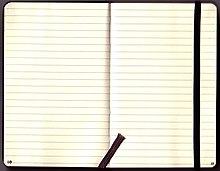Moleskine
Moleskine is a notebook , calendar , sketchbook and folio brand manufactured by Moleskine SpA, an Italian company based in Milan. Moleskine notebooks are typically bound in coated cardboard, with an elastic rubber band to keep the book closed, a stitched spine that allows the notebook to be opened flat, cream-colored paper, rounded corners, a bookmark and a folding pocket at the end of the book, everything is packaged through a paper band. Since 2011, other products related to writing, traveling and reading have also been produced, such as bags, reading glasses, pens, pencils, small mobile reading lamps for books, cases and lecterns.
history
Notebooks with the same characteristics as today's Moleskine notebooks were a popular standard in Europe in the 19th and 20th centuries, handcrafted by small French bookbinders who supplied the Parisian stationery stores. As documented by many art collections and museums, these nameless notebooks became a prominent creative tool for avant-garde artists who enjoyed drawing and writing outdoors, capturing impressions on paper, in the late 19th century through the early 20th century Drawing life on the street and in the cafes and capturing unprepared scenes, ideas and feelings.
The current Moleskine notebook was specifically designed from the descriptions of the notebooks Bruce Chatwin used on his travels. The name "Moleskine" itself is a nickname that Chatwin used in one of his most famous works, Dream Paths (1986). In this book, Chatwin tells the fictional story of his original notebook supplier, a Parisian stationery retailer, who informed him in 1986 that the last notebook maker - a small family business in Tours - had ceased production that year after the owner's death. “Le vrai Moleskine n'est plus” ( Eng. “The real Moleskine doesn't exist anymore”) are the words that Chatwin put in the mouth of the owner of the stationery shop on Rue de l'Ancienne Comédie. The word "moleskine" (also "molesquine", French pronunciation [mɔ.lɛs.kin]) is the French variant of the English " Moleskin " (mole skin, English pronunciation [ˈmoːlskɪn]), which describes a coated cotton fabric that is used for School bags, tablecloths and also as reference material for the cover of those notebooks mentioned. In German usage, similar bound stationery was called "oilcloth notebook". The Moleskine brand notebooks that have been produced since 1997 are not covered with such a fabric. The Italian manufacturers adopted the French spelling, the pronunciation is deliberately left unclear, in Italian the end-e is sometimes also spoken.
In 1997 a small company in Milan called Modo & Modo SpA decided to bring the small black notebooks back to life, registered the Moleskine trademark and started producing Moleskine notebooks with a print run of 5000 pieces. In 1999 Modo & Modo SpA started sales outside Italy, in Europe and in the United States. In 2004, Moleskine notebooks reached Japan and from there Moleskine began to spread to the rest of Asia. Presumably borrowing from the literary and cultural heritage of Moleskine notebooks, bookstores and design stores are the main distribution channel everywhere.
According to an article in the International Herald Tribune , the company's small workforce was unable to meet demand in 2006. In August 2006, the French investment fund Société Générale bought Modo & Modo SpA and started investing in expansion. The name of the company was changed to “Moleskine Srl”. Moleskine has been a public limited company (SpA) since the end of 2012 and was listed on the Milan Stock Exchange on April 3, 2013. In September 2016, the Belgian investment holding D'Ieteren acquired a 41% stake in Moleskine for the first time; this was increased to 100% following a public takeover offer in early 2017.
Moleskine production
Moleskine products are designed in Italy. Most of them are printed, stitched and sewn in China. Large-format flounces, cahiers, folios and hard cover collections have been produced in Turkey since 2008. The watercolor paper is supplied by a French specialist manufacturer.
Moleskine notebooks are made from chlorine-free paper. Only the paper for the tome collection is certified by the Forest Stewardship Council (FSC).
Debates
Moleskine does not have an official pronunciation as it is a “brand name with no specific national identity”. The Italian pronunciation is [ˌmɔleˈskine].
Web links
- Moleskine German
- Hilmar Poganatz: Notebook for creative people . In: Süddeutsche.de, May 17, 2010, accessed on November 26, 2013.
Individual evidence
- ↑ Bruce Chatwin: The Songlines , Penguin Books, 1988 reissue, ISBN 0-14-009429-6 , p. 160
- ^ Center Nationale de Ressources Textuelles et Lexicales, Lexicography: "Moleskine, Molesquine"
- ↑ Website of the manufacturer, June 30, 2016 : "Many Moleskine users send us inquiries as to which is the correct way of pronouncing the word" Moleskine ". The answer is: there is no predetermined answer."
- ↑ Fiona Ehlers: Stories in the Mole's Skin. Der Spiegel 28/2013, accessed July 3, 2016
- ↑ Horowitz, Jason (October 16, 2004), “Does a Moleskine notebook tell the truth?”
- ↑ Moleskine.com, [1]
- ↑ Handelsblatt.com, April 3, 2013
- ↑ marketplace.org: Moleskine's CEO on paper's advantages (and how to pronounce Moleskine)

